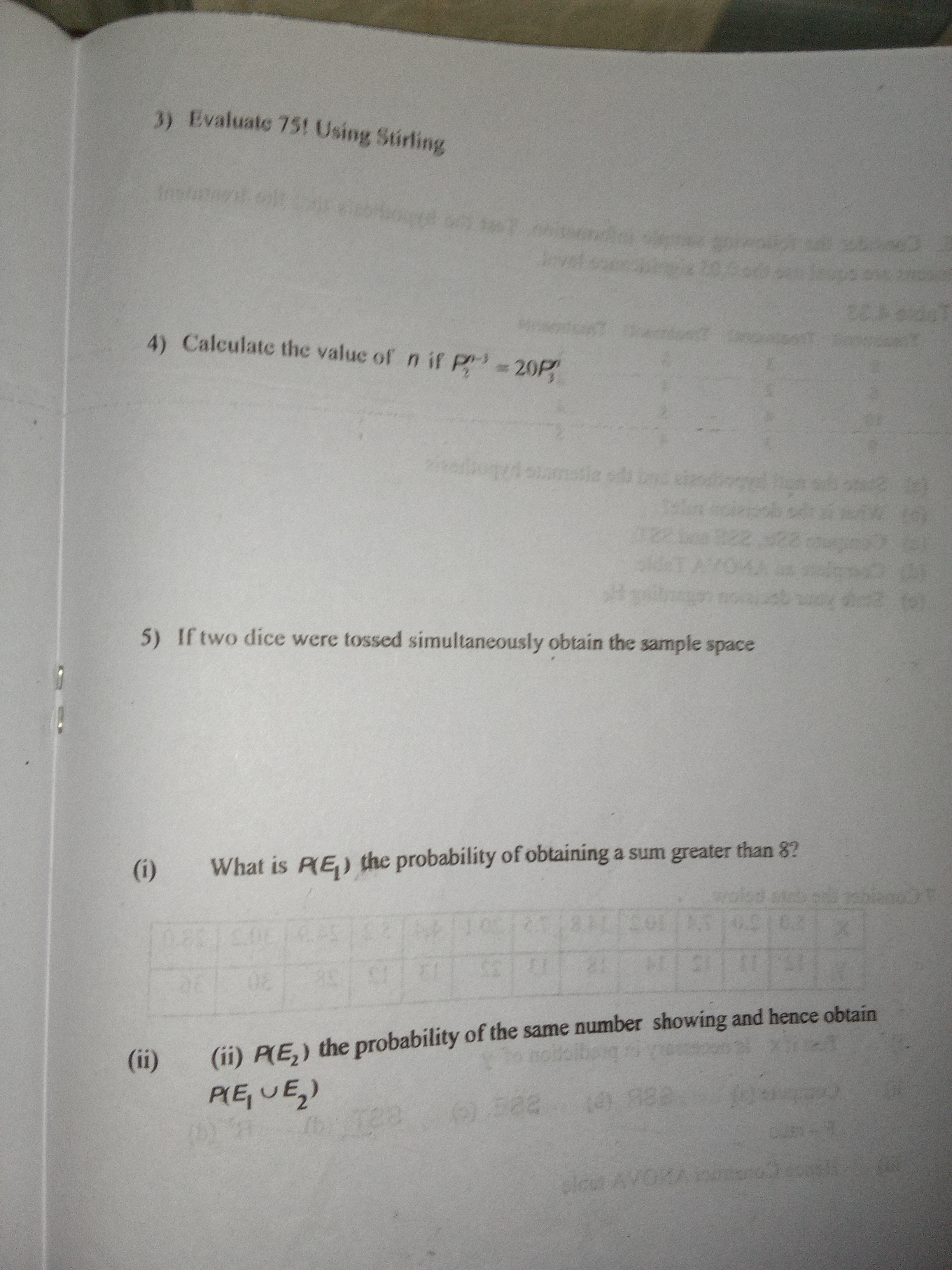3) Evaluate 75! using Stirling. 4) Calculate the value of n if P(n, 3) = 20P(n, 2). 5) If two dice were tossed simultaneously, obtain the sample space and answer: (i) What is P(E1)... 3) Evaluate 75! using Stirling. 4) Calculate the value of n if P(n, 3) = 20P(n, 2). 5) If two dice were tossed simultaneously, obtain the sample space and answer: (i) What is P(E1), the probability of obtaining a sum greater than 8? (ii) P(E2), the probability of the same number showing, and hence obtain P(E1 ∪ E2)?

Understand the Problem
The questions in the image are focused on evaluating mathematical concepts, specifically in probability and combinatorics. Question 3 requires evaluating a factorial using Stirling's approximation. Question 4 requires solving for a variable in a permutation equation. Question 5 deals with probability regarding dice rolls, specifically calculating probabilities related to sums and conditions.
Answer
1. $75! \approx \sqrt{2\pi \cdot 75} \left(\frac{75}{e}\right)^{75}$ 2. $n = \frac{1}{20} + 2$ 3. $P(E1) = \frac{5}{18}$, $P(E2) = \frac{1}{6}$, $P(E1 \cup E2) = \frac{7}{18}$
Answer for screen readers
- $75! \approx \sqrt{2\pi \cdot 75} \left(\frac{75}{e}\right)^{75}$
- $n = \frac{1}{20} + 2$
- $P(E1) = \frac{5}{18}$, $P(E2) = \frac{1}{6}$, $P(E1 \cup E2) = \frac{7}{18}$
Steps to Solve
- Evaluate 75! using Stirling's Approximation
Stirling's approximation is given by: $$ n! \approx \sqrt{2\pi n} \left(\frac{n}{e}\right)^n $$
For $75!$, we can substitute $n = 75$: $$ 75! \approx \sqrt{2\pi \cdot 75} \left(\frac{75}{e}\right)^{75} $$
- Calculate the value of n from the permutation equation
The formula for permutations is: $$ P(n, r) = \frac{n!}{(n - r)!} $$
For $P(n, 3)$, we have: $$ P(n, 3) = \frac{n!}{(n - 3)!} $$
For $P(n, 2)$, we have: $$ P(n, 2) = \frac{n!}{(n - 2)!} $$
So, the equation becomes: $$ \frac{n!}{(n - 3)!} = 20 \cdot \frac{n!}{(n - 2)!} $$
Simplifying gives: $$ \frac{1}{(n - 3)!} = 20 \cdot \frac{1}{(n - 2)(n - 3)!} $$ $$ 1 = 20(n - 2) $$ $$ n - 2 = \frac{1}{20} $$ $$ n = \frac{1}{20} + 2 $$
- Obtain the sample space for two dice
The sample space when two dice are rolled consists of 36 outcomes, represented as pairs $(x, y)$ where $x$ and $y$ can each be 1 to 6.
- Calculate P(E1)
We need the sum greater than 8. The outcomes satisfying this condition are: (3,6), (4,5), (4,6), (5,4), (5,5), (5,6), (6,3), (6,4), (6,5), (6,6).
So, there are 10 favorable outcomes: $$ P(E1) = \frac{10}{36} = \frac{5}{18} $$
- Calculate P(E2)
The outcomes where both dice show the same number are: (1,1), (2,2), (3,3), (4,4), (5,5), (6,6).
So, there are 6 favorable outcomes: $$ P(E2) = \frac{6}{36} = \frac{1}{6} $$
- Find P(E1 ∪ E2)
Using the formula for the union of two probabilities: $$ P(E1 \cup E2) = P(E1) + P(E2) - P(E1 \cap E2) $$
The intersection, $P(E1 \cap E2)$, is where outcomes satisfying both conditions exist (only pairs (5,5) and (6,6) give sum > 8): So $P(E1 \cap E2) = \frac{2}{36} = \frac{1}{18}$.
Finally, $$ P(E1 \cup E2) = \frac{5}{18} + \frac{1}{6} - \frac{1}{18} $$
Convert $\frac{1}{6}$ to an 18th denominator: $$ P(E1 \cup E2) = \frac{5}{18} + \frac{3}{18} - \frac{1}{18} = \frac{7}{18} $$
- $75! \approx \sqrt{2\pi \cdot 75} \left(\frac{75}{e}\right)^{75}$
- $n = \frac{1}{20} + 2$
- $P(E1) = \frac{5}{18}$, $P(E2) = \frac{1}{6}$, $P(E1 \cup E2) = \frac{7}{18}$
More Information
Stirling's approximation is a helpful tool for estimating the factorial of large numbers, minimizing computational complexity. In combinatorics, permutations are widely used to count arrangements, while probability with dice illustrates fundamental concepts of randomness and sample space.
Tips
- Misapplying Stirling's approximation by neglecting the square root term.
- Incorrectly setting up the permutation equations.
- Failing to identify all outcomes in the sample space for calculating probabilities.
AI-generated content may contain errors. Please verify critical information